Pre-Stack Seismic Data-Driven Pre-Salt Carbonate Reef Reservoirs Characterization Methods and Application
Abstract
:1. Introduction
2. Target Overview
3. Methods
3.1. Wavelet Decomposition Technology
3.2. Multi-Parameter Adaptive Pre-Stack Simultaneous Inversion Method
3.3. Pre-Salt Carbonate Porosity Prediction Technology
4. Results
5. Discussion
5.1. Seismic Response Characteristics of Reef Reservoirs
5.2. Analysis of Seismic Waveform Interface Characteristics
6. Conclusions
- 1.
- The heterogeneity of carbonate reservoirs and huge overlying rock salt make the pre-salt signal very weak. At the same time, many places show blank reflections on the seismic reflection profile, and the resolution of seismic exploration data is low. The method based on wavelet frequency decomposition processing can reasonably depict hidden details and improve the quality of pre-salt seismic signals.
- 2.
- The high-precision pre-stack multiple elastic parameters simultaneous inversion method used in this paper based on Bayesian theory can obtain good reservoir inversion results and depict the growth of reefs. After that, elastic parameter inversion was performed, the Poisson’s ratio profile and profile can also describe the shape of the reef. To further consider whether the reef reservoir contains oil, this paper considers the study of physical parameters to characterize the oil-bearing reef as a better explanation.
- 3.
- The inversion of physical property parameters based on the K-T model can obtain good porosity inversion results. Based on the high-precision pre-stack inversion in this paper, the physical property inversion method is studied. The final porosity inversion result can describe the reef more clearly than the pre-stack multiple elastic parameters inversion result and the elastic parameter inversion result, and the porosity result can better explain the oil-bearing properties of the reservoir. The inversion result is consistent with the actual drilling rock sample data and well data.
- 4.
- This article proposed a new seismic reservoir characterization method for reference, which provides new ideas for predicting and further researching pre-salt carbonate reef reservoirs in the future.
Author Contributions
Funding
Data Availability Statement
Acknowledgments
Conflicts of Interest
References
- Terra, G.J.S.; Spadini, A.R.; Franca, A.B. Carbonate rock classification applied to Brazilian sedimentary basins. Boletin De Geociencias Da Petrobras 2010, 18, 9–29. [Google Scholar]
- Rezende, M.F.; Pope, M.C. Importance of depositional texture in pore characterization of subsalt microbialite carbonates, offshore Brazil. Geol. Soc. Lond. Spec. Publ. 2015, 418, 193–207. [Google Scholar] [CrossRef]
- Wright, V.P.; Barnett, A.J. An abiotic model for the development of textures in some South Atlantic early Cretaceous lacustrine carbonates. Geol. Soc. Lond. Spec. Publ. 2015, 418, 209–219. [Google Scholar] [CrossRef]
- Eberli, G.P.; Baechle, G.T.; Anselmetti, F.S.; Incze, M.L. Factors controlling elastic properties in carbonate sediments and rocks. Lead. Edge 2003, 22, 600–654. [Google Scholar] [CrossRef]
- Roehl, P.O.; Choquette, P.W. Carbonate Petroleum Reservoirs; Springer Science and Business Media: Berlin, Germany, 2012. [Google Scholar]
- Kerans, C. Karst-controlled reservoir heterogeneity in Ellenburger Group carbonates of west Texas. AAPG Bull. 1988, 72, 1160–1183. [Google Scholar]
- Lucia, F.J. Rock-fabric/petrophysical classification of carbonate pore space for reservoir characterization. AAPG Bull. 1995, 79, 1275–1300. [Google Scholar]
- Lucia, F.J.; Kerans, C.; Jennings, J.W. Carbonate reservoir characterization. J. Pet. Technol. 2003, 55, 70–72. [Google Scholar] [CrossRef]
- Borromeo, O.; Luoni, F.; Bigoni, F.; Camocino, D.; Francesconi, A. Stratigraphic architecture of the early Carboniferous reservoir in Karachaganak field, Pri-Caspian basin (Kazakhstan). In Proceedings of the SPE Caspian Carbonates Technology Conference, Atyrau, Kazakhstan, 8–10 November 2010. [Google Scholar] [CrossRef]
- Alsharhan, A.S.; Magara, K. Nature and distribution of porosity and permeability in Jurassic carbonate reservoirs of the Arabian Gulf Basin. Facies 1995, 32, 237–253. [Google Scholar] [CrossRef]
- Keith, B.D. Reservoirs resulting from facies-independent dolomitization: Case histories from the Trenton and Black River carbonate rocks of the Great Lakes area. Carbonates Evaporites 1986, 1, 74–82. [Google Scholar] [CrossRef]
- Zhao, W.Z.; Zhu, G.Y.; Zhang, S.C.; Zhao, X.F.; Sun, Y.S.; Wang, H.J.; Yang, H.J.; Han, J.F. Relationship between the later strong gas-charging and the improvement of the reservoir capacity in deep Ordovician carbonate reservoir in Tazhong area, Tarim Basin. Chin. Sci. Bull. 2009, 54, 3076–3089. [Google Scholar] [CrossRef]
- Zou, C.N.; Xu, C.C.; Wang, Z.C.; Hu, S.Y.; Yang, G.; Li, J.; Yang, M.; Yang, Y. Geological characteristics and forming conditions of the platform margin large reef-shoal gas province in the Sichuan Basin. Pet. Explor. Dev. 2011, 38, 641–651. [Google Scholar]
- Zhao, Z.Y.; Guo, Y.R.; Xu, W.L.; Zhang, Y.L.; Gao, J.R.; Zhang, Y.Q. Significance of three reservoir profiles for the risk exploration in Ordos Basin. Pet. Explor. Dev. 2011, 38, 16–22. [Google Scholar]
- Ge, R.Q.; Song, C.C.; Chun, P.; Wang, R.L.; Zhang, D.W.; Xu, H.Z. Restudy on the Shahejie Formation transgression of the Paleocene in Zhan-Che sag (Jiyang depression). Geol. J. China Univ. 2003, 9, 450–457. [Google Scholar]
- Ma, Y.Z.; Gomez, E.; Young, T.J.; Cox, D.L.; Luneau, B.; Iwere, F. Integrated reservoir modeling of a Pinedale tight-gas reservoir in the Greater Green River Basin, Wyoming. In Uncertainty Analysis and Reservoir Modeling: AAPG Memoir 96; AAPG: Tulsa, OK, USA, 2011; pp. 89–106. [Google Scholar]
- Lima, B.E.M.; De Ros, L.F. Deposition, diagenetic and hydrothermal processes in the Aptian Pre-Salt lacustrine carbonate reservoirs of the northern Campos Basin, offshore Brazil. Sediment. Geol. 2019, 383, 55–81. [Google Scholar] [CrossRef]
- Ryder, R.T.; Fouch, T.D.; Elson, J.H. Early Tertiary sedimentation in the western Uinta Basin. Bull. Geol. Soc. Am. 1976, 87, 496–512. [Google Scholar] [CrossRef]
- Coogan, A.H.; Parker, M.M. Six potential trapping plays in Ordovician Trenton Limestone, Northwestern Ohio. Oil Gas J. 1984, 82, 121–126. [Google Scholar]
- Mancini, E.A.; Llinas, J.C.; Parcell, W.C.; Aurell, M.; Badenas, B.; Leinfelder, R.R.; Benson, D.J. Upper Jurassic thrombolite reservoir play, northeastern Gulf of Mexico. AAPG Bull. 2004, 88, 1573–1602. [Google Scholar] [CrossRef]
- Van Tuyl, J.; Alves, T.M.; Cherns, L. Geometric and depositional responses of carbonate build-ups to Miocene sea level and regional tectonics offshore northwest Australia. Mar. Pet. Geol. 2018, 94, 144–165. [Google Scholar] [CrossRef]
- Zhao, W.Z.; Shen, A.J.; Hu, S.Y.; Zhang, B.M.; Pan, W.Q.; Zhou, J.G.; Wang, Z.C. Geological conditions and distributional features of large-scale carbonate reservoirs onshore China. Pet. Explor. Dev. 2012, 39, 1–14. [Google Scholar] [CrossRef]
- Tavakoli, V. Carbonate Reservoir Heterogeneity: Overcoming the Challenges; Springer Nature: Basingstoke, UK, 2019. [Google Scholar]
- Riding, R. Microbial carbonates: The geological record of calcified bacterial–algal mats and biofilms. Sedimentology 2000, 47, 179–214. [Google Scholar] [CrossRef]
- Ahr, W.M. Geology of Carbonate Reservoirs: The Identification, Description and Characterization of Hydrocarbon Reservoirs in Carbonate Rocks; John Wiley and Sons: Hoboken, NJ, USA, 2011. [Google Scholar]
- Moore, C.H.; Wade, W.J. Carbonate Reservoirs: Porosity and Diagenesis in a Sequence Stratigraphic Framework; Elsevier: Amsterdam, The Netherlands, 2013. [Google Scholar]
- Mohriak, W.U.; Perdomo, L.V.; Plucenio, D.M.; Saad, J. Challenges for petrophysical characterization of presalt carbonate reservoirs. In Proceedings of the 14th International Congress of the Brazilian Geophysical Society EXPOGEF, Rio de Janeiro, Brazil, 3–6 August 2015; pp. 623–627. [Google Scholar]
- Saller, A.; Rushton, S.; Buambua, L.; Inman, K.; McNeil, R.; Dickson, J.A.D. Presalt stratigraphy and depositional systems in the Kwanza Basin, offshore Angola. AAPG Bull. 2016, 100, 1135–1164. [Google Scholar] [CrossRef]
- Ronchi, P.; Ortenzi, A.; Borromeo, O.; Claps, M.; Zempolich, W. Depositional setting and diagenetic processes and their impact on the reservoir quality in the late Visean–Bashkirian Kashagan carbonate platform (Pre-Caspian Basin, Kazakhstan). AAPG Bull. 2010, 94, 1313–1348. [Google Scholar] [CrossRef]
- Kenter, J.A.M.; Harris, P.M.; Collins, J.F. The Microbial-Dominated Slopes of Tengiz Field, Pricaspian Basin, Kazakhstan. In Proceedings of the Core Workshop: American Association of Petroleum Geologists Hedberg Conference on Microbial Carbonate Reservoir Characterization, Houston, TX, USA, 4–8 June 2012; p. 4. [Google Scholar]
- Collins, J.F.; Katz, D.; Harris, P.M.; Narr, W. Burial Cementation and Dissolution in Carboniferous Slope Facies, Tengiz Field, Kazakhstan: Evidence for Hydrothermal Activity. In Proceedings of the AAPG Search and Discovery Article, London, UK, 27 January 2014; Volume 20234. [Google Scholar]
- Searle, A.; Xing, H.; Iskakov, E.; Jazbayev, K.; Jenkins, S.D.; Lee, K.S.; McLean, N. A Comprehensive Anisotropic Velocity Model Building Case Study—Tengiz Full Azimuth Land TTI PSDM. In Proceedings of the 76th EAGE Conference and Exhibition, Amsterdam, The Netherlands, 16–19 June 2014. [Google Scholar]
- Cheng, T.; Kang, H.Q.; Bai, B. Key technologies and their application in exploration of pre-salt lacustrine carbonate rock in Santos basin, Brazil. China Offshore Oil Gas 2018, 30, 27–35. [Google Scholar]
- Gomes, J.P.; Bunevich, R.B.; Tedeschi, L.R.; Tucker, M.E.; Whitaker, F.F. Facies classification and patterns of lacustrine carbonate deposition of the Barra Velha Formation, Santos Basin, Brazilian Pre-salt. Mar. Pet. Geol. 2020, 113, 104–176. [Google Scholar] [CrossRef]
- De Paula Faria, D.L.; dos Reis, A.T.; de Souza, O.G., Jr. Three-dimensional stratigraphic-sedimentological forward modeling of an Aptian carbonate reservoir deposited during the sag stage in the Santos basin, Brazil. Mar. Pet. Geol. 2017, 88, 676–695. [Google Scholar] [CrossRef]
- Yang, X.L. Comparison of subsalt hydrocarbon accumulation characteristics in basins on both sides of the Mid-South Atlantic. Offshore Oil. 2019, 3, 1–8. [Google Scholar]
- Wu, J.; Zhao, P.F.; Wang, H.; Wang, Y.Q.; Li, J.G. Paleogeomorphology of the barra velha formation in block a of the Santos Basin, Brazil, and its control over reservoirs. Mar. Geol. Front. 2019, 35, 56–62. [Google Scholar]
- Alves, T.M.; Fetter, M.; Lima, C.; Cartwright, J.A.; Cosgrove, J.; Ganga, A.; Queiroz, C.L.; Strugale, M. An incomplete correlation between pre-salt topography, top reservoir erosion, and salt deformation in deep-water Santos Basin. Mar. Pet. Geol. 2017, 79, 300–320. [Google Scholar] [CrossRef]
- Kuster, G.T.; Toksoz, M.N. Velocity and attenuation of seismic waves in two-phase media: Part, I. Theoretical formulations. Geophysics 1974, 39, 587–606. [Google Scholar] [CrossRef]
- Mavko, G.; Mukerji, T.; Dvorkin, J. The Rock Physics Handbook: Tools for Seismic Analysis of Porous Media; Cambridge University Press: Cambridge, UK, 1998. [Google Scholar]
- Williams, B.G.; Hubbard, R.J. Seismic stratigraphic framework and depositional sequences in the Santos Basin, Brazil. Mar. Pet. Geol. 1984, 1, 90–104. [Google Scholar] [CrossRef]
- Ojeda, H. Structural framework, stratigraphy and evolution of Brazilian marginal basins. AAPG Bull. 1982, 66, 732–749. [Google Scholar]
- Cainelli, C.; Mohriak, W.U. Geology of Atlantic eastern Brazilian basins. Braz. Geol. Part 1998, 2, 1998. [Google Scholar]
- Szatmari, P.; Milani, E.; Lana, M.; Conceicao, J.; Lobo, A. How South Atlantic rifting affects Brazilian oil reserves. Oil Gas J. 1985, 83, 107–113. [Google Scholar]
- Cainelli, C.; Mohriak, W.U. Some remarks on the evolution of sedimentary basins along the Eastern Brazilian continental margin. Epis.-Newsmag. Int. Union Geol. Sci. 1999, 22, 206–216. [Google Scholar] [CrossRef] [Green Version]
- Stanton, N.; Ponte-Neto, C.; Bijani, R.; Masini, E.; Fontes, S.; Flexor, J.M. A geophysical view of the Southeastern Brazilian margin at Santos Basin: Insights into rifting evolution. J. S. Am. Earth Sci. 2014, 55, 141–154. [Google Scholar] [CrossRef]
- Castagna, J.P.; Sun, S. Comparison of spectral decomposition methods. First Break 2006, 24. [Google Scholar] [CrossRef]
- Weinstein, S.; Ebert, P. Data transmission by frequency-division multiplexing using the discrete Fourier transform. IEEE Trans. Commun. Technol. 1971, 19, 628–634. [Google Scholar] [CrossRef]
- Griffin, D.; Lim, J. Signal estimation from modified short-time Fourier transform. IEEE Trans. Acoust. Speech Signal Process. 1984, 32, 236–243. [Google Scholar] [CrossRef]
- Zhang, R.; Fomel, S. Time-variant wavelet extraction with a local-attribute-based time-frequency decomposition for seismic inversion. Interpretation 2017, 5, 9–16. [Google Scholar] [CrossRef]
- Sinha, S.; Routh, P.S.; Anno, P.D.; Castagna, J.P. Spectral decomposition of seismic data with continuous-wavelet transform. Geophysics 2005, 70, 19–25. [Google Scholar] [CrossRef]
- Huang, H.D.; Zhang, R.W.; Guo, Y.C. Wavelet frequency-division process for seismic signals. J. Oil Gas Technol. 2008, 30, 87–91. [Google Scholar]
- Rhif, M.; Ben Abbes, A.; Farah, I.R.; Martínez, B.; Sang, Y. Wavelet transform application for/in non-stationary time-series analysis: A review. Appl. Sci. 2019, 9, 1345. [Google Scholar] [CrossRef] [Green Version]
- Portniaguine, O.; Castagna, J. Inverse spectral decomposition. SEG Tech. Program Expand. Abstr. 2004, 2004, 1786–1789. [Google Scholar]
- Vetterli, M.; Herley, C. Wavelets and filter banks: Theory and design. IEEE Trans. Signal Process. 1992, 40, 2207–2232. [Google Scholar] [CrossRef] [Green Version]
- Resnikoff, H.L.; Raymond, O., Jr. Wavelet Analysis: The Scalable Structure of Information; Springer Science and Business Media: Berlin, Germany, 2012. [Google Scholar]
- Shensa, M.J. The discrete wavelet transform: Wedding the a trous and Mallat algorithms. IEEE Trans. Signal Process. 1992, 40, 2464–2482. [Google Scholar] [CrossRef] [Green Version]
- Tian, X.D.; Huang, H.D.; Luo, Y.N. Deepwater sub-salt carbonate reef reservoir prediction in Santos Basin, Brazil. SEG Tech. Program Expand. Abstr. 2019, 2019, 534–538. [Google Scholar]
- Huang, H.D.; Yuan, S.Y.; Zhang, Y.T.; Zeng, J.; Mu, W.T. Use of nonlinear chaos inversion in predicting deep thin lithologic hydrocarbon reservoirs: A case study from the Tazhong oil field of the Tarim Basin, China. Geophysics 2016, 81, B221–B234. [Google Scholar] [CrossRef]
- Liu, Z.S.; Sun, Z.D.; Dong, N.; Liu, J.Z.; Liu, Z.X.; Wang, Y.J. A modified Kuster-Toksöz rock physics model and its application. Oil Geophys. Prospect. 2018, 53, 113–121. [Google Scholar]
- Gassmann, F. Elastic waves through a packing of spheres. Geophysics 1951, 16, 673–685. [Google Scholar] [CrossRef]

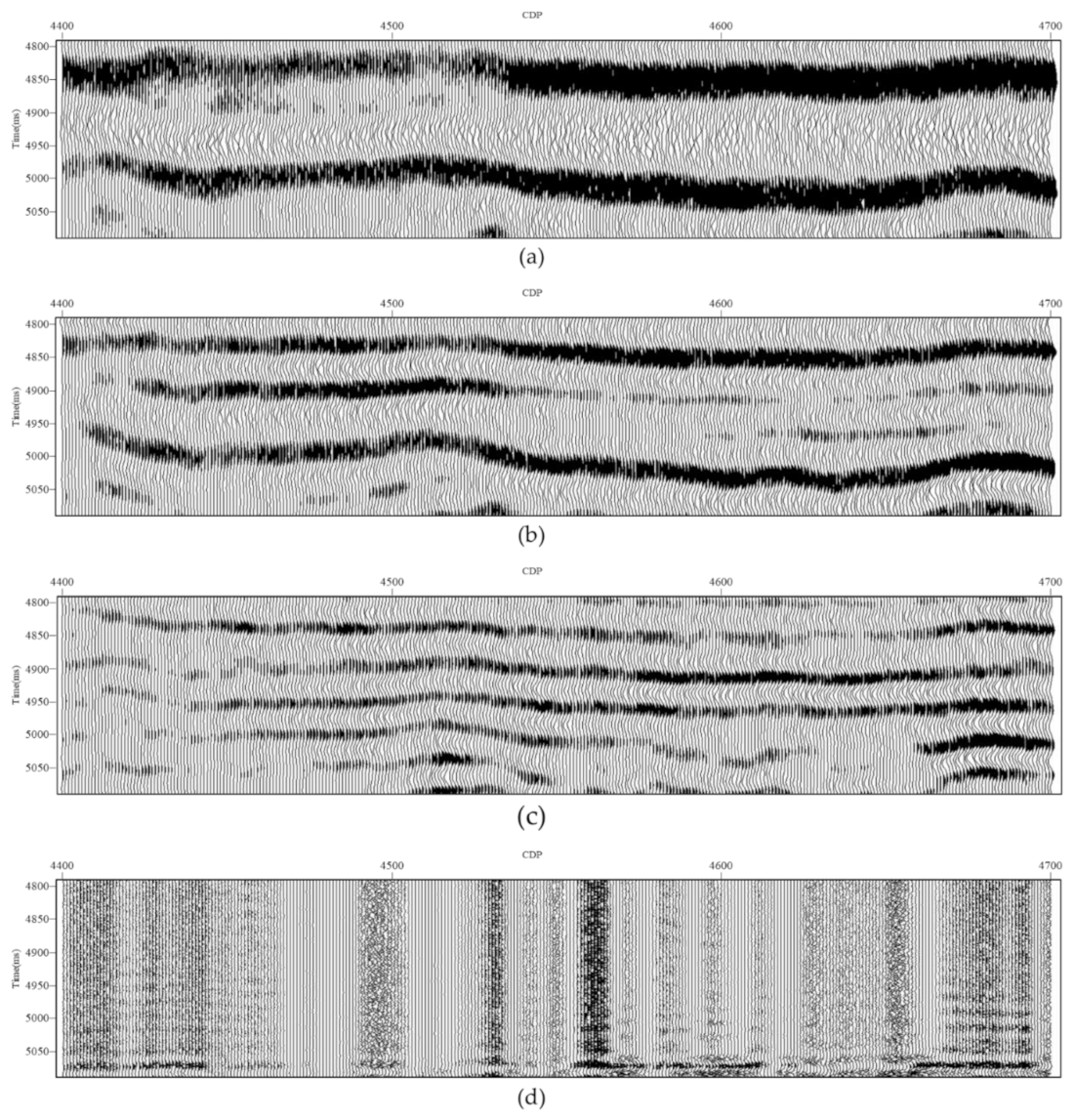
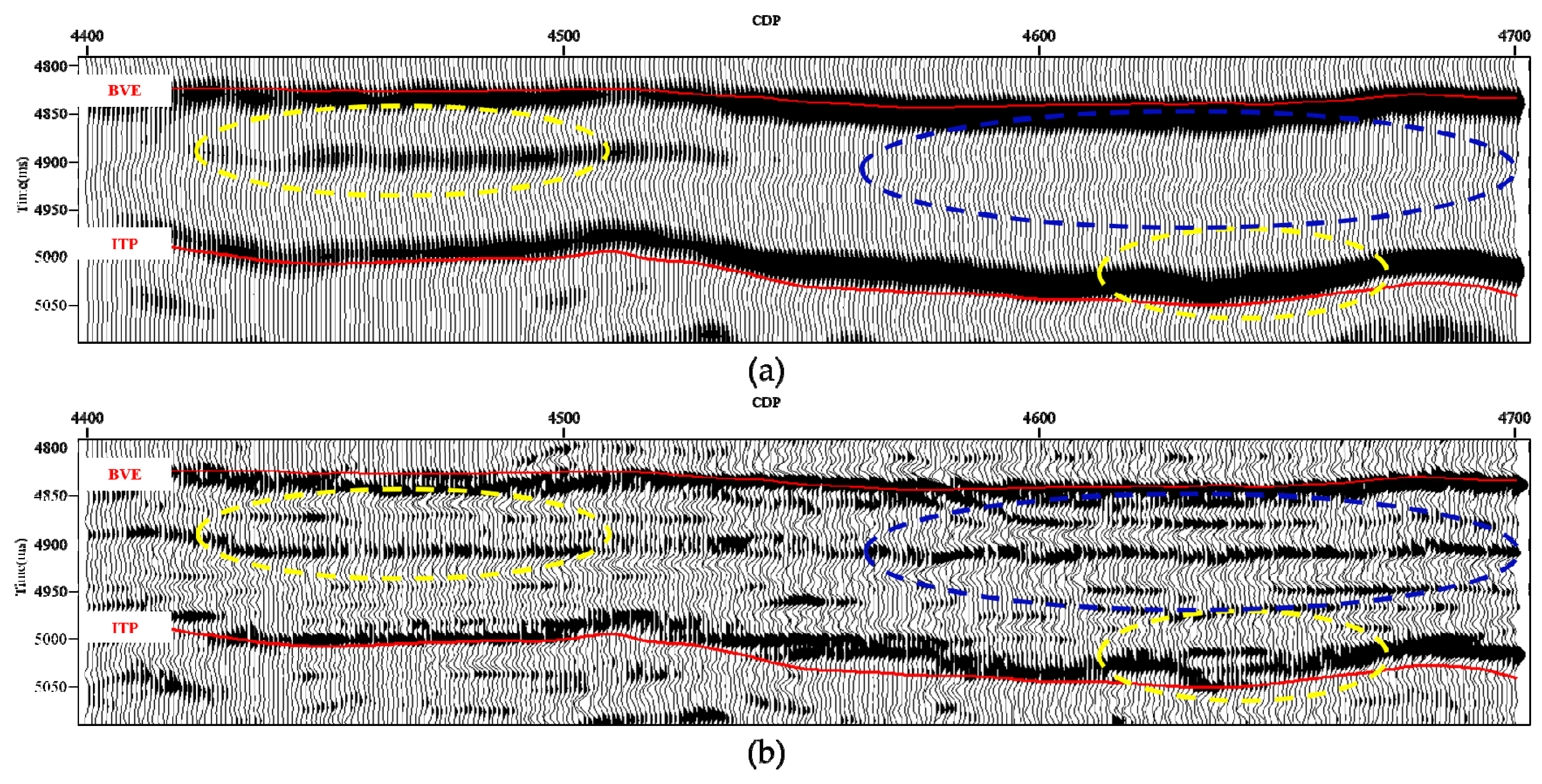

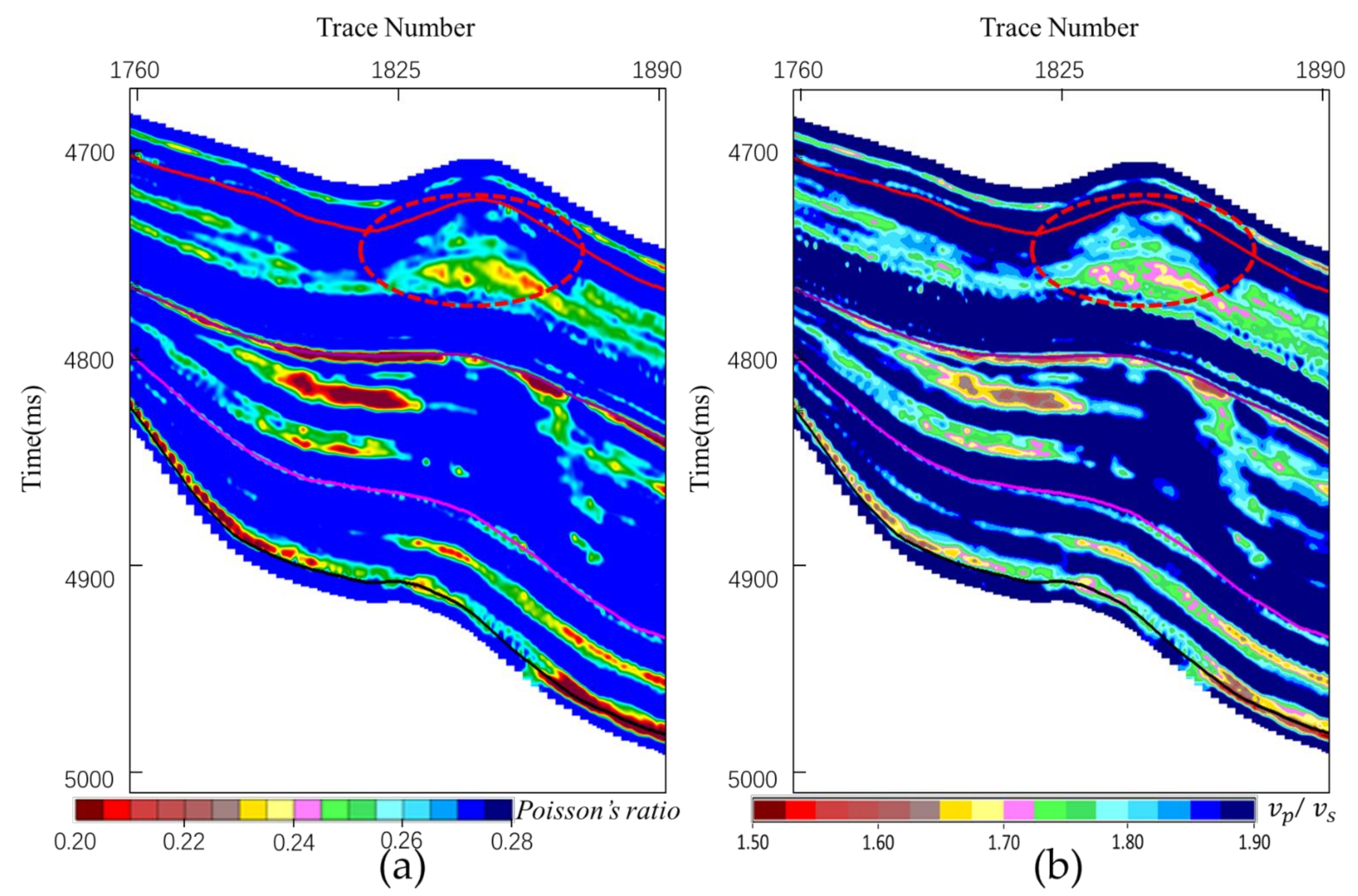
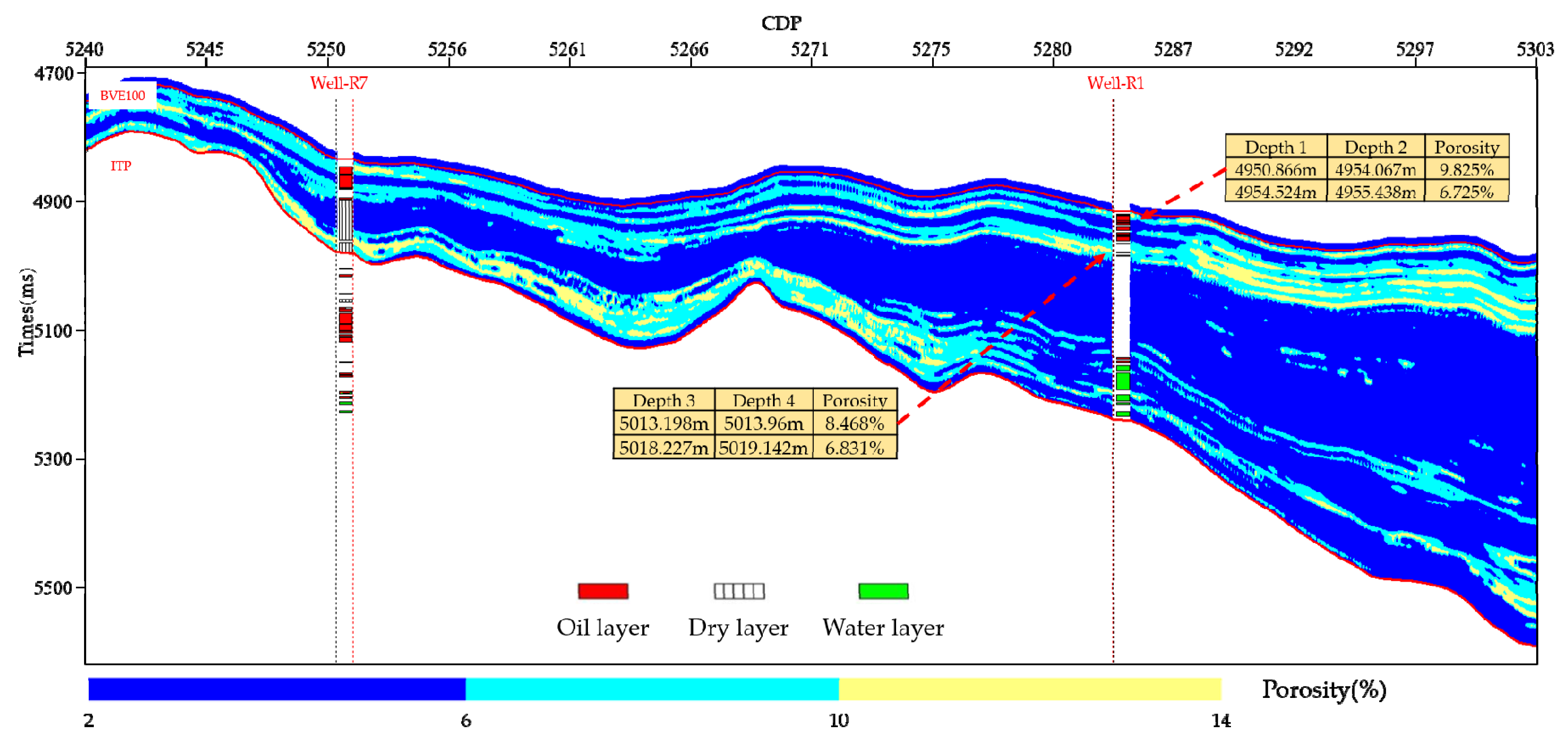

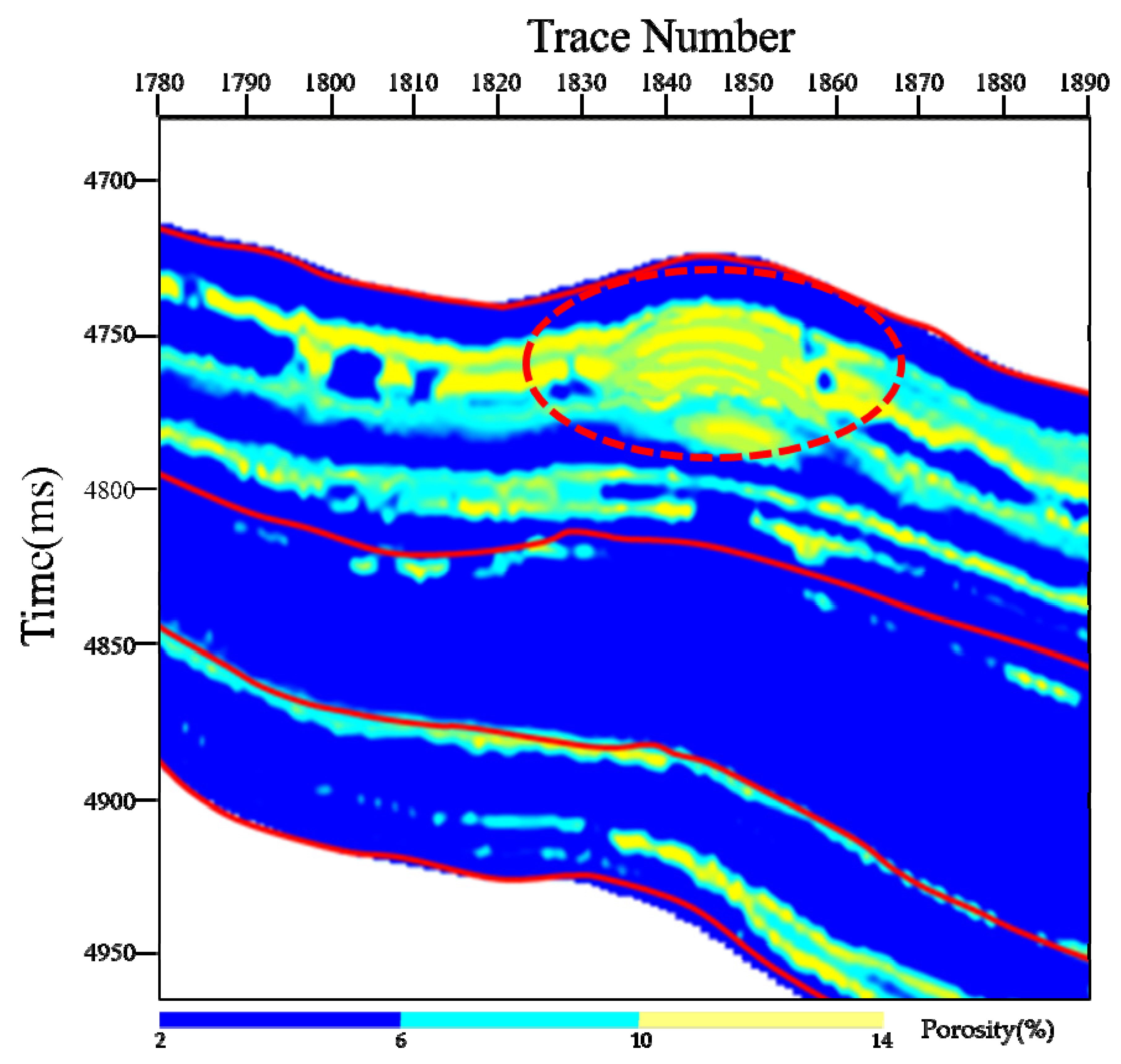



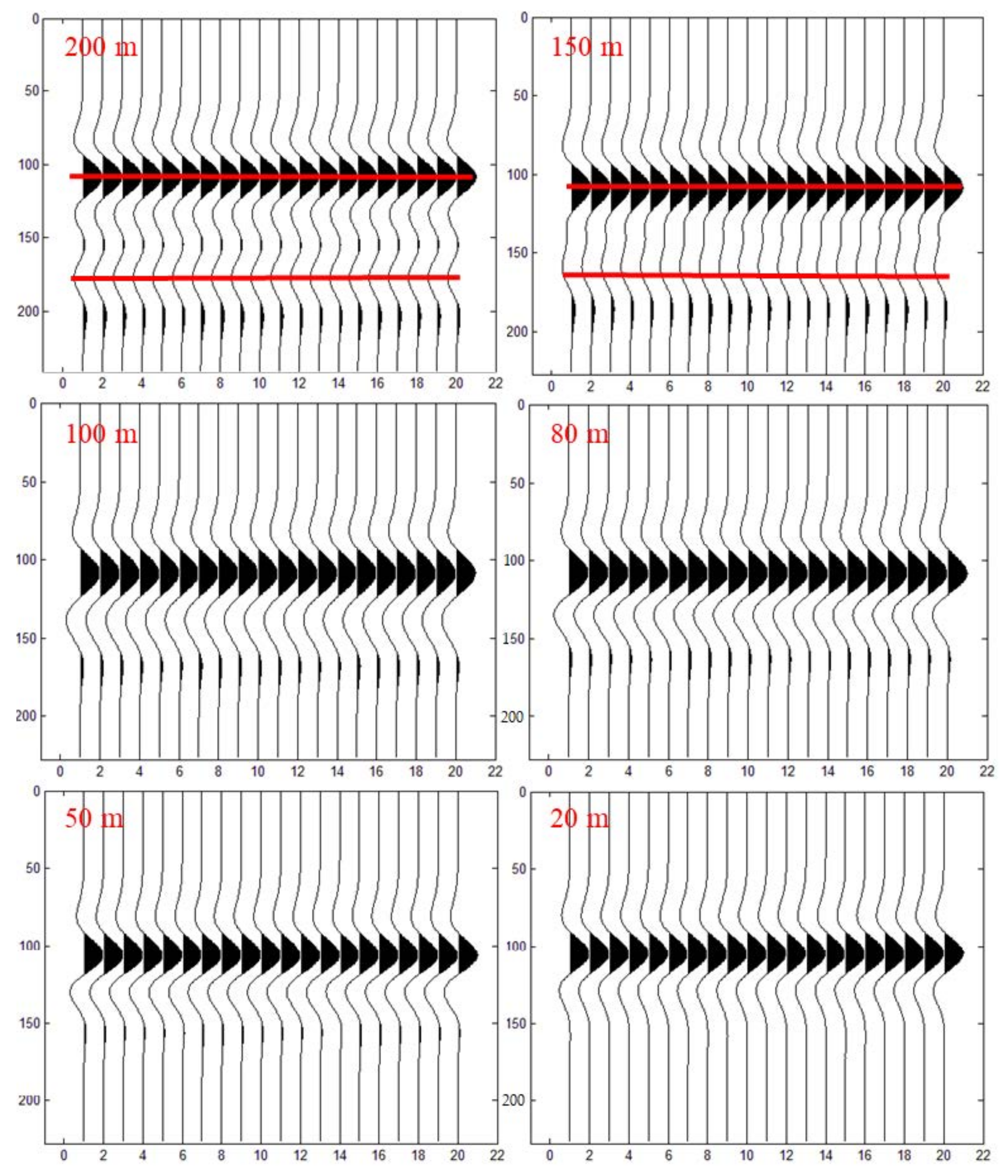
Publisher’s Note: MDPI stays neutral with regard to jurisdictional claims in published maps and institutional affiliations. |
© 2021 by the authors. Licensee MDPI, Basel, Switzerland. This article is an open access article distributed under the terms and conditions of the Creative Commons Attribution (CC BY) license (https://creativecommons.org/licenses/by/4.0/).
Share and Cite
Tian, X.; Huang, H.; Gao, J.; Luo, Y.; Zeng, J.; Cui, G.; Zhu, T. Pre-Stack Seismic Data-Driven Pre-Salt Carbonate Reef Reservoirs Characterization Methods and Application. Minerals 2021, 11, 973. https://doi.org/10.3390/min11090973
Tian X, Huang H, Gao J, Luo Y, Zeng J, Cui G, Zhu T. Pre-Stack Seismic Data-Driven Pre-Salt Carbonate Reef Reservoirs Characterization Methods and Application. Minerals. 2021; 11(9):973. https://doi.org/10.3390/min11090973
Chicago/Turabian StyleTian, Xingda, Handong Huang, Jun Gao, Yaneng Luo, Jing Zeng, Gang Cui, and Tong Zhu. 2021. "Pre-Stack Seismic Data-Driven Pre-Salt Carbonate Reef Reservoirs Characterization Methods and Application" Minerals 11, no. 9: 973. https://doi.org/10.3390/min11090973




